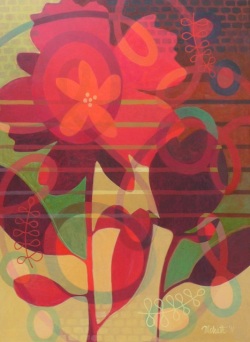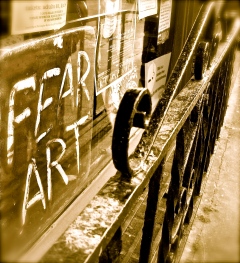Last night, as my hubby was catching up on my blog posts ( he reads them all, even if he has to sit and catch up on a week’s worth at a time, such a good hubby! ), over his shoulder I re-read my In Search Of post from last week and man, what a whiney little whiner! To save you all from more self-pity-filled posts from me, sweet George took me on a day trip to Astoria, OR on Saturday, in the hopes of helping me feel a bit more connected to the 3-dimensional art world. You know, the one that doesn’t live inside my laptop.

Astoria, Oregon
Despite the gray day, my spirits were sunny. Astoria’s main claim to fame is the movie, The Goonies, which was filmed here way back in 1985 ( yes, we made a children of the 80’s pilgrimage to The Goonies House ). But movie history isn’t the only draw to Astoria. Its downtown area is super charming, filled with a mix of restaurants, coffee houses, shops and YES, some very interesting and diverse galleries.
Our first stop was Lightbox Photographic, a wonderful little gallery dedicated to the photographic arts. Their current show, Plastic Fantastic II, features images created using plastic toy cameras. Absolutely beautiful, emotion-filled images. Be sure to check out their website to see images created their member photographers.

Inside Lightbox Photographic
Astoria was definitely starting out with a bang! We continued our walking tour of downtown, stopping for coffee and treats along the way. Right across from the Astoria Coffeehouse, was Lunar Boy Gallery, whose quirky-look caught my eye. And LunarBoy definitely brought the quirk. June 7th was Astoria’s Official Goonies Day, so Lunar Boy was exhibiting a special show of Goonies-related work. Fun!

This Is Our Time Now! Goonies Show at Lunar Boy

Landscapes by Nicholas Knapton at Lunar Boy
After lots of cool art & laughs at Lunar Boy, we perused a few bookstores & other shops ( it can’t be ALL about me ) before finding RiverSea Gallery. This contemporary gallery features a wide variety of work by artists from the Northwest and beyond. I was thrilled to find that their current show, The Fabled Landscape, featured the work of Marla Baggetta.

Artist, Marla Baggetta
Since my days of specifying art for the corporate & healthcare industries, I’ve been a fan of Baggetta, her landscapes bring that perfect combination of happy color and peace, perfect especially for healthcare. Her work is even more lush and gorgeous in it’s original state than her reproductions even begin to show. I was in awe.

Artist, Marla Baggetta

Artist, Marla Baggetta
Though seeing Baggetta’s original work was a highlight for me, RiverSea had many other artists whose work caught my eye. Like…

Maple wood sculpture by Michael Hampel

Encaustics by Paula Blackwell

Figurative work by Shannon Richardson

Wonderful urban landscapes by Brin Levinson
George had his favorites, too– like the work of abstract mixed-media artist, Charles Schweigert ( told you he was loving abstracts now! ) and kooky sculptures by Pamela Mummy.

Namikaze by Charles Schweigert

A Lot on His Mind by Pamela Mummy
Our little day trip to Astoria was just what the art doctor ordered. I was able to peruse some lovely, unique galleries and found some really interesting artists to share with you. We even spotted a couple of empty storefronts that would make great galleries.. you know, just in case.
Tags: abstract art, art, Artists, Astoria, Brin Levinson, Charles Schweigert, figurative art, galleries, Landscapes, Lightbox Photographic, Lunar Boy Gallery, Marla Baggetta, Michael Hampel, mixed media, Nicholas Knapton, Paintings, Pamela Mummy, Paula Blackwell, photography, RiverSea Gallery, sculpture, Shannon Richardson, The Goonies, websites

























































